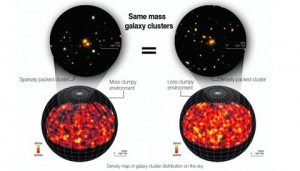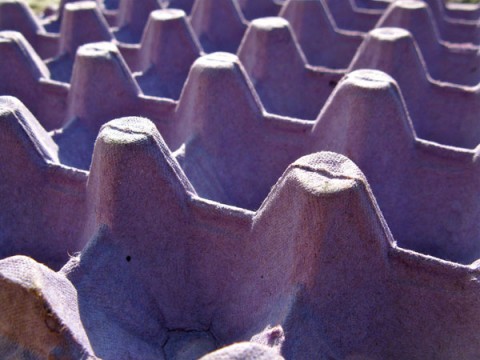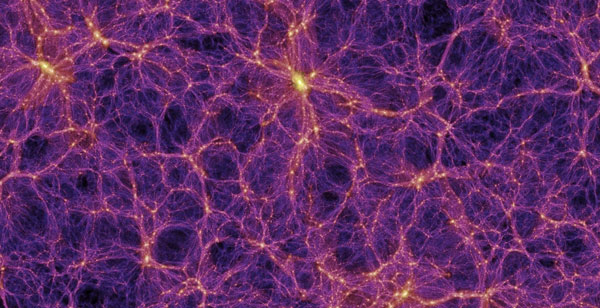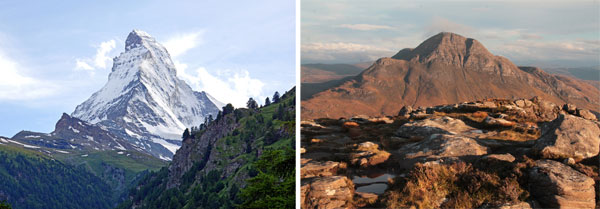Observations of nearly 9,000 galaxy clusters support the idea that fast-forming clusters huddle together more.

Sloan Digital Sky Survey / Kavli IPMU
The largest building blocks in the universe are galaxy clusters. Galaxy clusters are what they sound like: clusters of galaxies, linked by their mutual gravity. They’re big, maybe millions of light-years wide, and can contain thousands of galaxies.
Galaxy clusters are the lights that trace out the contours of cosmic structure. But they’re only the tip of the proverbial iceberg: dark matter forms the cosmic web’s skeleton. Clusters sit in big halos of dark matter, and the more massive the cluster, the more dark matter is there. We know there’s something like ten times more matter than what we see in these clusters because, if there weren’t, the galaxies zooming around a cluster would be able to escape — the cluster would fly apart.
Theorists fabulously recreate cosmic structure using simulations that contain only dark matter and gravity. But there’s a prediction of such simulations that astronomers have been having trouble finding evidence for in the real world. That prediction is called assembly bias. Instead of matter’s clustering behavior depending solely on mass, assembly bias says that clusters will form faster or slower depending on how dense the dark matter is in their surrounding environment.
This density isn’t the density of the dark matter halo in which the cluster sits. Rather, it’s on a larger scale: it’s the density of the environment in which the halo sits. This is a difficult concept to grasp, so as an analogy, think of an egg crate:

The egg crate represents the density of dark matter in the cosmos. Places where the density is high are the peaks in the egg crate; places where the density is low are the troughs. These peaks and troughs are leftovers from the earliest days of the universe, inconsistencies that subsequently led to the formation of the cosmic web:

Millennium Simulation Project
Unlike an egg crate, though, dark matter density peaks are not all equally “peaky.” Some have steep sides, where there’s a shear drop-off in density. Others have gentle slopes, where density falls off more gradually.

Halos sit on top of these density peaks. A cluster on a shear drop can have the same mass as a cluster on a gentle slope, but if assembly bias exists, a cluster on top of the steep peak will have formed slower than the cluster on the gentle slope. This is because massive structures tend to suck in material more rapidly as they grow if they’re surrounded by regions of higher density, where there’s a larger supply of mass.
If that’s true, then fast-formed clusters should lie closer together than slow-formed clusters. In other words, fast-formed clusters should cluster.
These predictions came from work done by Neal Dalal (now at University of Illinois at Urbana-Champaign) and others. But observers need clusters of exactly the same mass to test the theory in the real universe, and those have been hard to find: previous analyses have only revealed hints that assembly bias might exist.
Hironao Miyatake (Princeton, Kavli IPMU of University of Tokyo, and JPL) and colleagues set out to try again. They gathered 8,648 clusters from the Sloan Digital Sky Survey and divided them into two groups: fast-forming and slow-forming. Then they “weighed” the clusters by examining how the clusters’ masses gravitationally distorted background light from more distant galaxies. That way, they confirmed they were working with samples of equal masses.
When the team looked at how clustered the two types of clusters were, the researchers found that indeed, the fast-forming clusters were more touchy-feely with their neighbors — exactly what assembly bias predicts. The team reported the result January 25th in Physical Review Letters.
This result relies on a proxy to determine how fast a galaxy cluster formed, namely the distribution of galaxies within the clusters. The team is now working to more directly measure the rates at which the clusters accreted mass. And astronomers still need to confirm that assembly bias exists within clusters, a daunting task. But as Dalal writes in an informative opinion piece, “The confirmation of assembly bias means that cosmologists can breathe a temporary sign of relief.” If it hadn’t panned out, he explains, cosmology might have been in trouble. For now, it looks like physics works the way we think it does.
Well, probably.
If you’d like more information, I recommend Dalal’s write-up, or you can check out the press releases from JPL and the University of Tokyo's Kavli IPMU.
References:
Miyatake, Hironao et al. “Evidence of Halo Assembly Bias in Massive Clusters.” Physical Review Letters. Vol 116. January 25, 2016.
Dalal, Neal. “Some Assembly Required.” Physics (American Physical Society “Viewpoint” piece). January 25, 2016.
Already behind on your New Year's resolution? Start again: make a resolution to stay more informed about astronomy with a subscription to Sky & Telescope.
 0
0









Comments
You must be logged in to post a comment.